Surbana Jurong’s journey into one-north
Twenty years ago, Singapore set out a daring ambition: to build on its position as South East Asia’s premier global trading center and establish itself as a world leading knowledge hub. Throughout this journey, Surbana Jurong’s expertise has helped to guide the project from vision towards reality.
Singapore has always been a nation with ambition. Never more so in the 1990s, a new plan emerged to transform this small island nation from an independent, world leading trading center, into a global, knowledge-based economy.
The ambition required a new type of infrastructure. A purpose-built environment to attract the new breed of fast-growing information and intelligence-based industries and research and development companies – to create a world leading destination to which global talent and entrepreneurs naturally gravitated and turned their visions to reality.
The one-north development zone is the result of this ambition. It builds on the cluster strategy originally proposed in the late 1990’s by the Singapore’s National Science and Technology Board, now renamed A*Star (Agency for Science, Technology and Research). The name one-north itself is intended to reflect the scale of ambition. Originally called simply the Buona Vista Science Park, it was rebranded as one- north to reflect Singapore’s location 1 degree north of the Equator, and designed to avoid the vision of one-north being defined by its locality or the word Science.
It was a collaborative initiative involving various statutory boards and government agencies which formed a steering committee to guide direction and chart the roadmap for implementation. The committee comprised members from the Ministry of National Development (URA, HDB), Ministry of Law (Singapore Land Office), Ministry of Trade and Industry (EDB, JTC Corp) and Ministry of Transport (LTA). JTC Corporation took the leading role of developing and implementing the project.
The mission was clear: To gather and encourage communities of likeminded businesses, focus investment and create technology hubs dedicated to research and development. The master plan was envisioned as a mixed-use development incorporating different Work-Live-Play-Learn elements.
Long term partnership and collaboration
World renowned architect, the late Zaha Hadid, was commissioned in 2001 to produce the master plan and created a framework and concept for the development. However, throughout this 17-year project evolution, Surbana Jurong has been at the heart of work to create the physical manifestation of Hadid’s grand master plan. It was gradually realized through tangible buildings and infrastructure, with every stage reshaping the built environment to meet the needs of the community.
Each project in the development has presented unique challenges. As such the projects clearly highlighted many critical elements of the firm’s philosophy and approach to planning, design and construction.
Community is key. One unique feature for one-north is the requirement for all developers to invest in public artwork worth a minimum of 0.5% the construction cost of the project. The result is an art accessible and culturally rich area to which businesses and the community is drawn, underlining the mixed-use characteristics envisaged by the master plan and the organic growth of one-north.
Throughout this time, the work has evolved to reflect the various phases of developments in the diverse land use clusters and its industrial “epicenters”: from the initial Phase Z.ro start-up catalyst incubators, to the Biopolis biomedical research centers, Fusionopolis info-communications technology, and STT MediaHub and data center.
Vision for the future – Phase Z.ro
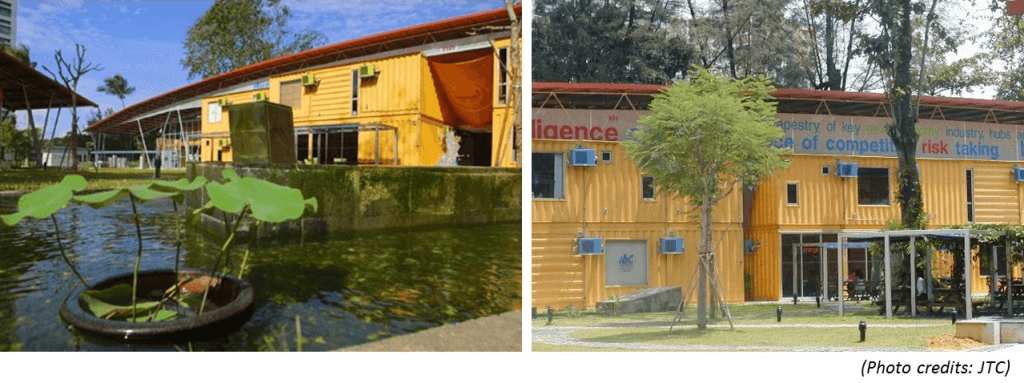
Building out this bold masterplan required JTC as the developer and Surbana Jurong its appointed consultant to lead a clear vision to kick start construction of the vast one-north development site. This began with the Phase Z.ro (pronounced Zee-Ro) development which effectively started the project, acting as a catalyst for development and an incubator for start-up technology companies.
This rapidly erected start-up cluster, located adjacent to the Ministry of Education headquarters, was constructed in 2001 from reused shipping containers and originally designed for just three years of temporary use.
The goal was to create a rapid, new and exciting buzz around the site; to draw in technology companies and so promote the one-north sector as next big moment in Singapore’s development. The project comprised 60 steel shipping containers stacked two units high, with common circulation spaces and shared amenities weaved between – designed and delivered at fast-pace to mirror the constantly changing and growing ethos of start-up technology and IT companies.
Tenants were provided with high speed broadband connectivity, shared meeting rooms with teleconferencing facilities, security and maintenance services. The development also doubled as JTC’s on site office as the next phases of one-north were rolled out.
Slightly later than intended, the offices were dismantled in 2008 with the containers and other components recycled for new uses. However, this interim and temporary use of the site had, in effect, set out the vision for the project as the breeding ground for new high tech businesses and talent.
Design with community and collaboration in mind – the Biopolis Cluster
Phase Z.ro reflected the vision for the one-north project – encapsulating the evolving nature of the knowledge industry, where start-up units dream of growing into larger companies, to become tenants of buildings and then eventually to own buildings as their businesses expand. Ideally, this rapid growth process would take place within one-north, with its growth matching the businesses around it.
As an enticing beginning, it set the pace for projects that followed. It also optimized the use of the land while the eventual permanent land parcels and infrastructure within the master plan were concurrently planned and rolled out.
The design of the Biopolis Cluster by Surbana Jurong was the start of this permanent plan; conceived as a biomedical research-and-development hub, and creating a cluster of professionals intended to encourage collaboration between major biotechnology companies and public research institutions.
Seven buildings, ranging from eight to 13 storeys, were completed by 2003 and are interconnected by skybridges and an extensive pedestrian network through its vast landscape and greenery.
The resulting design is a unique biomedical community. Its location adjacent to the Science Parks, the National University of Singapore, the National University Hospital, the Singapore Polytechnic and the Ministry of Education buildings, maximises the capability and resources across various disciplines and encourages greater collaboration.
The Matrix Building and its landscaped plaza form the “epicentre” of the entire Biopolis complex and with its cafes, shops, restaurants, child care centre, fitness club and a specialty bookshop, is designed to encourage community interaction. Six other buildings in the complex – Chromos, Helios, Centros, Genome, Proteos and Nanos – form an “outer ring” to the epicentre and shared facilities such as the library, laboratories, meeting rooms, and auditoriums, are again, designed to encourage collaboration.
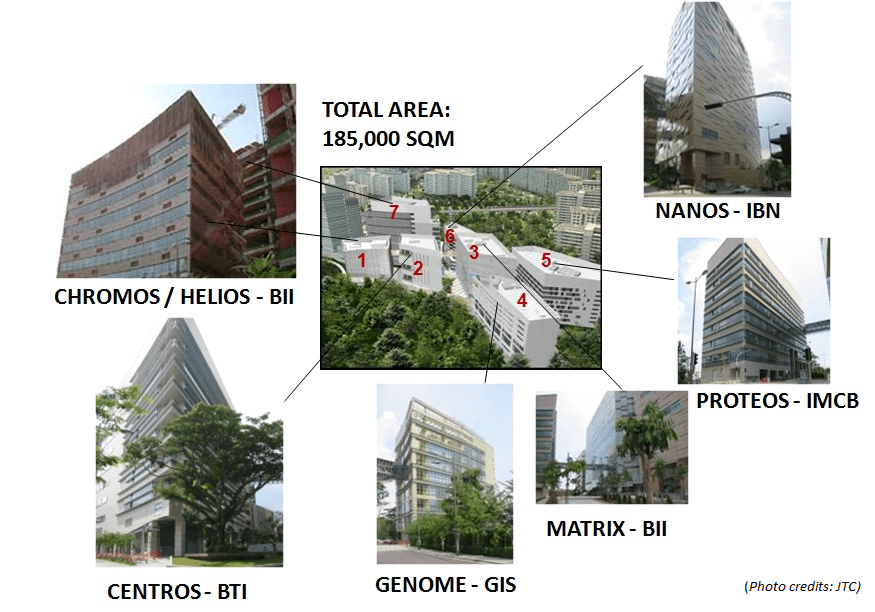
Embracing a commercial approach to the public realm – Biopolis Phases 2 and 3
It was always clear to the team at Surbana Jurong that Biopolis Phase 1, being the first phase development at one-north, would be a critical catalyst for investment in future developments. It would set the design standard for all subsequent developments and so become the main shop window for attracting the all-important future private investment.
This clear understanding of the commercial realities of property development meant that the Biopolis Phases 2 and 3, completed in 2008 and 2011 respectively, saw private sector developers roll in with confidence to support this government initiative.
Phase 2 was developed by Ascendas-Singbridge[1], while Phase 3 was by Crescendas Bionics[2]; both investments were direct testimony to the Biopolis 1 success and the appreciation that high, consistent design standards were key to one-north’s long term commercial attraction.
Technical and architectural excellence – Fusionopolis
The heart of this private sector attraction to one-north has also been a commitment by Surbana Jurong and other development partners to delivering technical and architectural excellence. The world class masterplan has, in reality, been consistently built out with world class infrastructure design and construction.
Fusionopolis Phase 1, completed in 2008, is one such example. The 1.2-hectare development is the first project implemented in one-north’s Central Exchange district and creates a cluster for the Information & Communication Technology (ICT) and Media industry sectors.
Quality is at the heart of the Surbana Jurong design for the project, construction of which kicked off in February 2002. At its core are two unique composite steel and concrete structure towers – which at 22 and 24 storeys are the clear landmark buildings for the otherwise low rise one-north development – a retail podium, a flexible-seating theatre pod and six basement levels.
The design is for a truly vertical city, featuring a high density and integrated mixed-use layout comprising offices, retail, food and beverage outlets, health club with a roof-top swimming pool, serviced apartments and a digital arts theatre. Direct integration with the one-north MRT station ensures that the building is accessible as a destination in the one-north zone.
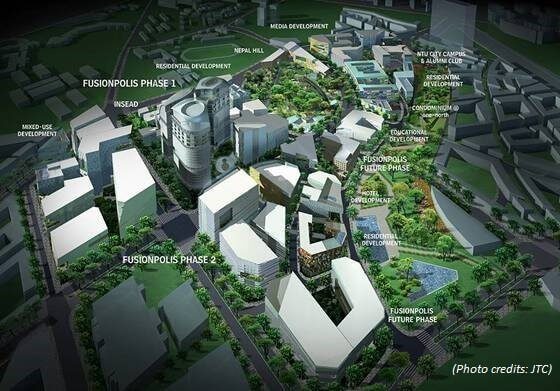
A cluster of curved sloping roofs creates a dramatic silhouette in the predominantly mid to low rise suburban landscape to underline the quality of design. Meanwhile, the technically intricate curtain wall façade and distinctive theatre pod – supported by a single “tree column” structure over a geometrically complex skylight – demonstrate the complex delivery – unique, yet simple and exciting.
Sustainable, secure and future proof design – STT Mediahub
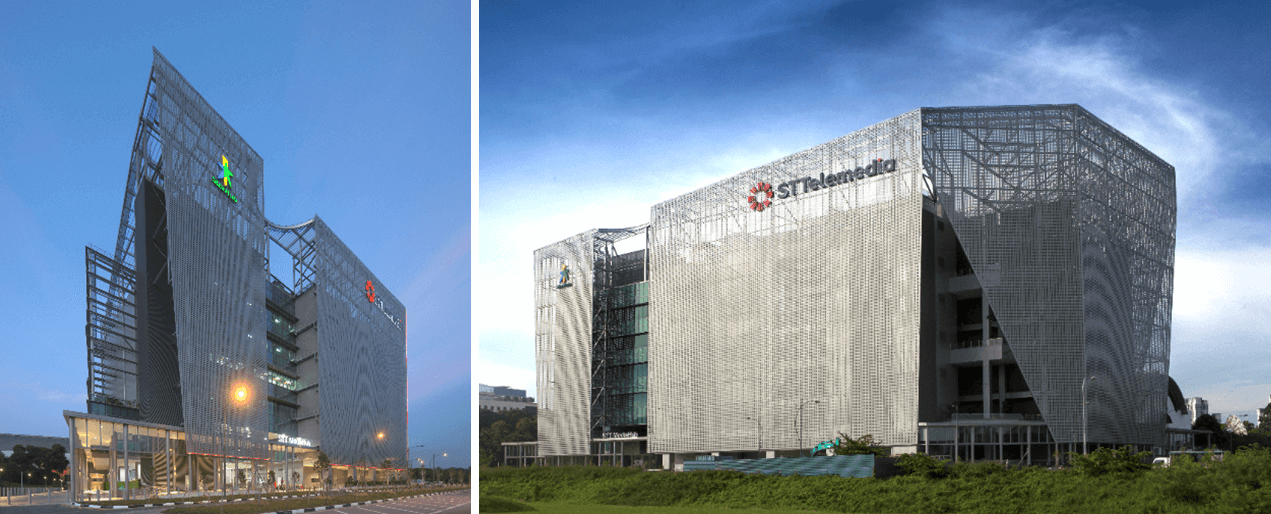
Priorities change and emerge on a project such as one-north which spans several decades. As such, to fulfil its role as a broadcast and data center, the STT MediaHub required stringent design specifications to boost resiliency and high security before opening in 2016.
The project was Surbana Jurong’s first foray into such a sensitive project. Services and utilities were designed for redundancies, and emissions from the heavy use of back-up generators had to be mitigated.
While the one-north project to date had promoted openness, integration, pedestrian connectivity and accessibility across its developments, on STT MediaHub the need to meet stringent security provisions were as challenging as they were incongruent with the rest of the scheme.
However, this challenge was mitigated by a unique layered design concept in which secured areas were carefully zoned and protected. The outer layers of the architectural form were thus articulated to meet need for public accessibility and open spaces – with a distinctive façade representing a suit of armour protecting the sensitive technically-charged areas within.
And despite being an energy guzzler, careful design meant the building achieved the BCA’s GreenMark Platinum award for Data Centre category, following extensive design work to develop and implement holistic integrated energy efficient measures and optimize the building’s power utilization efficiency. It is truly a development of the future.
Next steps for one-north and Surbana Jurong
Over the last two decades, the one-north project has enabled Surbana Jurong and its previous business incarnations to showcase unique built environment design talent and problem-solving skills. It has been a rich journey, allowing teams to gain great insights into the needs of life sciences, biomedical research and R&D professionals and then find the most appropriate infrastructure solutions.
We have learnt the value of a focused approach to meet the project requirements. And we have had to understand and design for flexibility and future proofing to meet JTC’s objective of catering to a wide range of tenants and users with specific needs.
It has been important work, helping to create not only a new development zone but also a major step for Singapore as it moves to become a world leading hub for the knowledge industry; ensuring that the projects have the capability to support as wide a range of business operations and so creating a major destination for technology entrepreneurs and scientific research.
The relevance of this is far-reaching, especially in the wake of one-north’s success in the eyes of the world. It is a thriving area, where an established scientific business community and start-ups companies mix effortlessly with universities and government institutions.
Yet the project is far from complete. Our journey continues as the one-north masterplan moves forward to its next investment.
______________________________________________________________________________________________________________________________________
Case Study 1: Biopolis
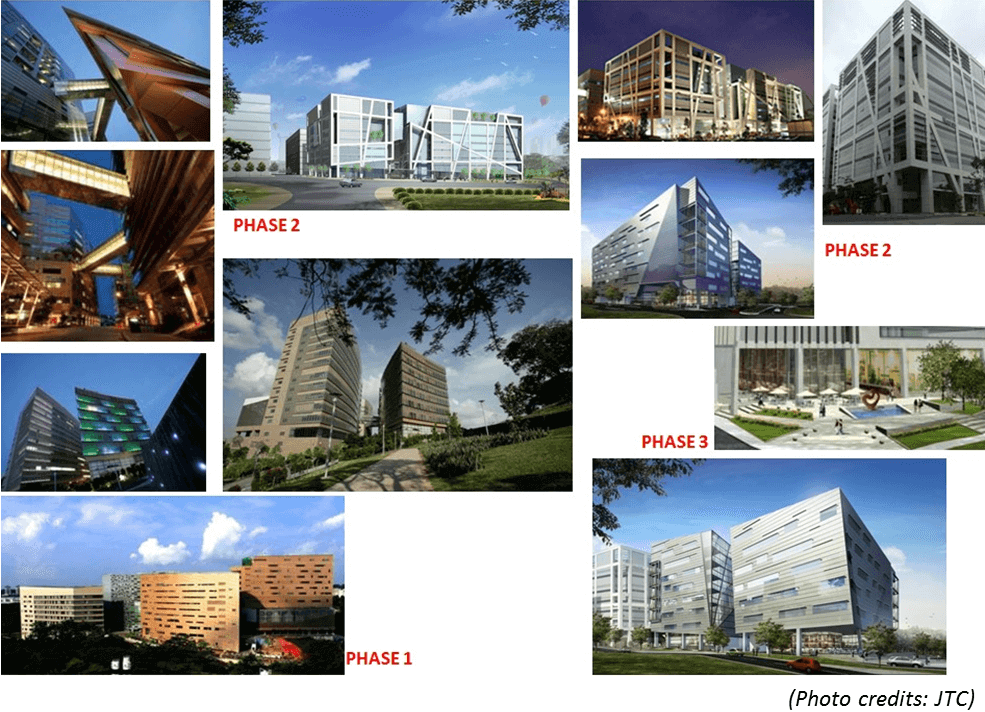
The design of Biopolis reflects the site’s existing ground contours. While the masterplan dictates its high density, high plot ratio and tight fragmented plots, the buildings are sympathetic to the site in that the existing terrains and trees are retained.
The building configuration and envelopes of Biopolis Phase 1 channel air into the spaces between, thereby generating a natural cooling airflow. Innovative systems such as the District Cooling System were also implemented, removing the need for air-conditioning cooling towers to be built into each building. This reduces the dissipation of heat from individual buildings and to preserve the roofscape.
The fragmented clustering effect also meant that smaller buildings retained distinct identity yet were integrated as a cohesive whole. The outdoor spaces between the buildings provide contrasting open public areas alongside more private and intimate streets and green pockets. As such, its compactness breaks away from the traditional street setbacks and provides shade to public open spaces, encouraging outdoor interaction and so boosting community interaction.
Design ingenuity was critical to fit the research laboratory requirements within the irregular building forms, dictated by the site configuration, while maximizing the building efficiency.
Similarly, designers worked hard to maintain the unique feel to each building while creating an identify of the overall Biomedical complex. A priority was to protect the privacy of each research institute while promoting a vibrant and stimulating hub for sharing of ideas and meeting of minds.
Biopolis also showcases modern technologies and government initiatives such as a Pneumatic Refuse Conveyance System for refuse disposal, a system designed with the community in mind. Energy conscious approaches, such as integrating photovoltaic cells within building façades, an Intelligent Building Automated System to actively reduce energy use.
Case Study 2: Fusionopolis
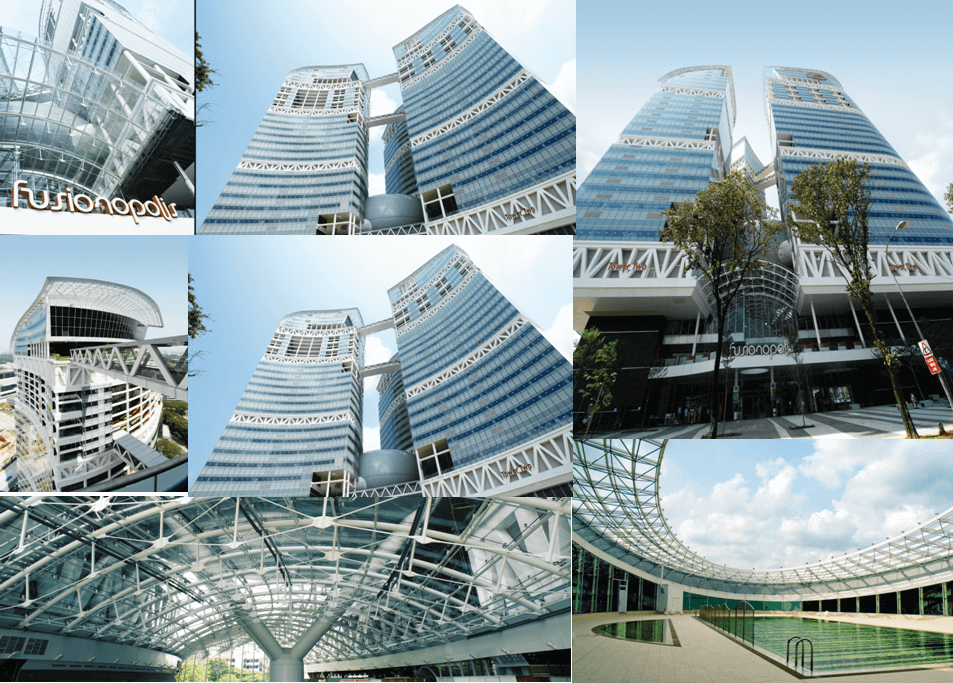
Conceived as an iconic structure for one-north, the Fusionopolis building possesses a distinctly recognizable and memorable external form. The architectural expression of the structure is achieved through the elegant and efficient use of structural steel in combination with reinforced concrete core walls.
Horizontal mega-trusses cantilever from the central core walls with each truss supporting approximately seven floors above. This also enables the floors to be elevated from the ground, thus affording expansive and structure-free spaces and creating a seamless ground plane between the building and its surroundings.
Sky Bridges strategically connect towers to offer visitors an exhilarating experience, while architectural lighting effects enhance the building at night. The skylight above the concourse draws vision upwards to the underside of the egg-shaped theatre pod and to the two towers rising above.
Shared amenities serve not only the users of the building but also the surrounding community, in particular the podium retail area which creates a buzz of activity. The deliberate interweaving of pedestrian routes through the development, a direct link to the MRT station, and the interconnecting voids and spaces at the podium and via the elevated SkyBridges, add to the connected feeling and so foster collaboration and cross-disciplinary cooperation.
Fusionopolis also boasts 13 public sky gardens, each landscaped with distinctive themes. These high-rise gardens provide visual relief, cooling opportunities and social interaction spaces while contributing to Singapore’s overall urban greening initiatives.
[1] Ascendas-Singbridge Group is Asia’s leading sustainable urban and business space solutions provider with Assets under Management exceeding S$20 billion.
[2] Crescendas is a multi-industry group with business interests in properties, hotels, building materials, logistics and distribution services, innovative and technological products, green energy and environmental friendly products.



 下载文件
下载文件
0 comments